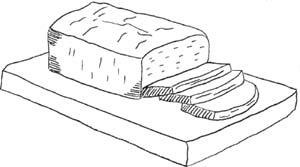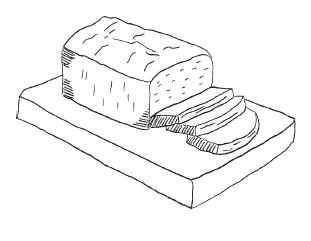Nourishing Traditions: The Cookbook That Challenges Politically Correct Nutrition and The... (136 page)
Authors: Sally Fallon,Pat Connolly,Phd. Mary G. Enig
Tags: #Non-Fiction, #Reference, #Science, #Health
Variation: Sourdough Herb and Nut Bread
To each loaf, add
1 tablespoon rosemary
or
1 tablespoon dill
during kneading and
¼ cup chopped crispy pecans or walnuts (
crispy pecans
)
at the end of the kneading process.
Variation: Sourdough Cheaters Bread
Use
3 cups unbleached white flour
and
10 cups whole wheat flour
for a lighter loaf.
Where do we find these lactic-acid-producing bacteria that cause milk to sour, that gives bread its aroma and that conserves vegetables? They are in the living soil and on healthy plants, in particular those that grow close to the soil. A protective coat of acid, truly an acid sheath, envelopes all higher organisms. In the mouth, the stomach, the intestine and in the reproductive organs one finds a flora that produces lactic acid. Annelies Schoneck
Des Crudites Toute L'Annee
No single substance will maintain vibrant health. Although specific nutrients are known to be more important in the functions of certain parts of the body, even these nutrients are totally dependent upon the presence of other nutrients for their best effects. Every effort should therefore be made to attain and maintain an adequate, balanced daily intake of all the necessary nutrients throughout life. Lavon J. Dunne
Nutrition Almanac
Raw honey is noteworthy for having considerable plant amylase. The amylase does not come from the bee but is a true plant enzyme, concentrated from the pollen of flowers. . .. If you wish to predigest a starchy food, such as bread, spread some raw honey on it. The moment the honey and bread come into contact, the honey enzyme starts predigestion; and as you chew more digestion takes place. If the bread with its honey-enzyme coating is allowed to stand at room temperature for 15 minutes before you eat it, there will be less work for salivary amylase. Edward Howell, MD
Enzyme Nutrition

SPICE BREAD
(Pain d'Epices)
Makes 2 9-inch rounds
4 cups freshly ground rye or spelt flour
1 cup raw honey
2 cups filtered water
2 teaspoons ground cinnamon
1 teaspoon ground coriander
1 teaspoon ground fennel
1 teaspoon ground cumin
1 teaspoon sea salt
grated rind of 2 oranges
½ cup sourdough starter
Mix spices, orange rind and salt with flour in a large bowl. Meanwhile, gently heat the honey with the water until honey is dissolved. Let cool. Make a well in the flour and place the starter in it. Gradually add the honey-water mixture, stirring with a wooden spoon. The dough should be more liquid than bread dough. Line two well-oiled, 9-inch cake pans with buttered parchment paper and divide the batter between the two pans. Cover with a damp towel and let rise in a warm place for at least 12 hours. Bake at 350 degrees for 1 hour. Let cool slightly and remove from pan. Leave at room temperature, covered, a day or two before eating.
In books on baking and even in nutritional/medical writings, the two techniques [for making bread], natural leaven (sourdough) and baker's yeast, are often mingled and confounded. . .. Baking with natural leaven is in harmony with nature and maintains the integrity and nutrition of the cereal grains used. . .. The process helps to increase and reinforce our body's absorption of the cereal's nutrients. Unlike yeasted bread that diminishes, even destroys, much of the grain's nutritional value, naturally leavened bread does not stale and, as it ages, maintains its original moisture much longer. A lot of that information was known pragmatically for centuries; and thus when yeast was first introduced in France at the court of Louis XIV in March 1668, because at that time the scientists already knew that the use of yeast would imperil the people's health, it was strongly rejected. Today, yeast is used almost universally, without any testing; and the recent scientific evidence and clinical findings are confirming the ancient taboos with biochemical and bioelectronic valid proofs that wholly support that age-old common sense decision.
Jacques DeLangre
We may live without poetry, music and art. . .We may live without conscience and live without hearts. . .We many live without friends. . .We may live without books. . .But civilized man cannot live without cooks.
Athenaeus
NATURAL YEAST BREAD
Makes 2 loaves
2 cups unwashed organic grapes, processed to pulp
4 cups freshly ground rye flour
1 tablespoon sea salt
7 cups freshly ground spelt, kamut or hard winter wheat flour
1 tablespoon sea salt
filtered water
This makes a slightly lighter sourdough loaf than the preceding sourdough recipe, but the bread is still too heavy for traditional sandwiches. The starter can be prepared in 3 days rather than 7.
Place 2 cups grape pulp and 2 cups freshly ground rye flour in a clean bowl. Mix well and cover with two layers of cheesecloth or a square of light cloth secured with a rubber band. Leave in a warm place. On day two, transfer to a clean bowl and add 1 cup rye flour and 1 cup filtered water. Mix well, cover with a cloth and leave in a warm place. On day three, transfer to a clean bowl and add the final cup of rye flour and 1 cup water. Mix well, cover with a cloth and leave in a warm place until starter gets frothy and subsides. You should have about 5 cups. Use 4 cups for making bread and save 1 cup in a jar in the refrigerator or freezer for a new batch of starter.
To make bread, combine 7 cups of flour with 4 cups starter, 1 tablespoon sea salt and about 1½ cups water. Mix well with a wooden spoon or with your hands. To knead, process in two different batches in food processor and place each batch in a well-buttered loaf pan. Cut a few slits in the top of the dough, cover and let rise in a warm place at least 12 hours. Bake at 300 degrees for about 1½ hours.
Variation: Natural Yeast Herb and Nut Bread
To each loaf, add
1 tablespoon rosemary
or
1 tablespoon dill
during kneading and
¼ cup chopped crispy pecans or walnuts (
crispy pecans
)
at the end of the kneading process.Variation: Natural Yeast Cheaters Bread
Use
2 cups unbleached white flour
and
5 cups whole wheat flour
for a lighter loaf
The nutrition of the people of the Loetschental Valley, particularly that of the growing boys and girls, consists largely of a slice of whole rye bread and a piece of the summer-made cheese (about as large as the slice of bread), which are eaten with fresh milk of goats or cows. Meat is eaten about once a week. In the light of our newer knowledge of activating substances, including vitamins, and the relative values of food for supplying minerals for body building, it is clear why they have healthy bodies and sound teeth. The average total fat-soluble activator and mineral intake of calcium and phosphorus of these children would far exceed that of the daily intake of the average American child. The sturdiness of the child life permits children to play and frolic bareheaded and barefooted even in water running down from the glacier in the late evening's chilly breezes, in weather that made us wear our overcoats and gloves and button our collars. Of all the children in the valley still using the primitive diet of whole rye bread and dairy products, the average number of cavities per person was 0.3. On an average it was necessary to examine three persons to find one defective deciduous or permanent tooth. The children examined were between seven and sixteen years of age. Weston Price, DDS
Nutrition and Physical Degeneration

YEASTED BUTTERMILK BREAD
Makes 2 loaves
4 cups freshly ground spelt, kamut or hard winter wheat flour
1-1½ cups buttermilk (
Cultured Butter and Buttermilk
or
Whole-Milk Buttermilk
), warm½ cup butter, melted
¼ cup warm water
1 package dry yeast
2 tablespoons honey
1 teaspoon salt
½ teaspoon baking soda
1 cup unbleached white flour.
This is a good compromise bread that can be sliced and used for sandwiches. Yeast is used, but the flour is soaked in buttermilk first.
Combine whole wheat flour, 1 cup buttermilk and butter in a food processor until a ball forms. If dough is too thick, add more buttermilk, but it should be thick enough to form a ball. Place in a bowl, cover with a towel and leave in a warm place for 12-24 hours.
Combine water, yeast and honey in a small bowl and leave for 5 minutes or until it bubbles. Add salt and baking soda and mix well. Place half the flour mixture, half the yeast mixture and ½ cup unbleached white flour in a food processor. Process until a smooth ball forms. Repeat with the other half of dough, yeast mixture and white flour.
Knead the two balls together briefly and place in a buttered bowl. Cover with a towel and let rise 2 hours, until doubled in bulk. Punch down, cut the dough in half and process each half in a food processor for 30 seconds each. Form into loaves and place in buttered loaf pans (preferably stoneware). Cover with a towel and let rise 1-2 hours, until doubled. Bake for 30 minutes at 350 degrees. Cool on racks.
Variation: Yeasted Buttermilk Rolls
Divide into about 24 balls instead of 2 loaves. Place in two buttered cake pans and let rise until doubled. Bake at 350 degrees for about 30 minutes. Cool on racks
Weston Price's studies convinced him that the best diet was one that combined nutrient-dense whole grains with animal products, particularly fish. The healthiest African tribe he studied was the Dinkas, a Sudanese tribe on the western bank of the Nile. They were not as tall as the cattle-herding Neurs groups but they were physically better proportioned and had greater strength. Their diet consisted mainly of fish and cereal grains. This is one of the most important lessons of Price's research—that a mixed diet of whole foods, one that avoids the extremes of the carnivorous Masai and the largely vegetarian Bantu, ensures optimum physical development.
Nasty, Brutish and Short?
Some health writers claim that saturated fats in the diet inhibit the production of prostaglandins, localized tissue hormones that govern many processes on the cellular level. Actually the reverse is true. Saturated fats in the diet improve the body's utilization of essential fatty acids and protect them from becoming rancid. . ..